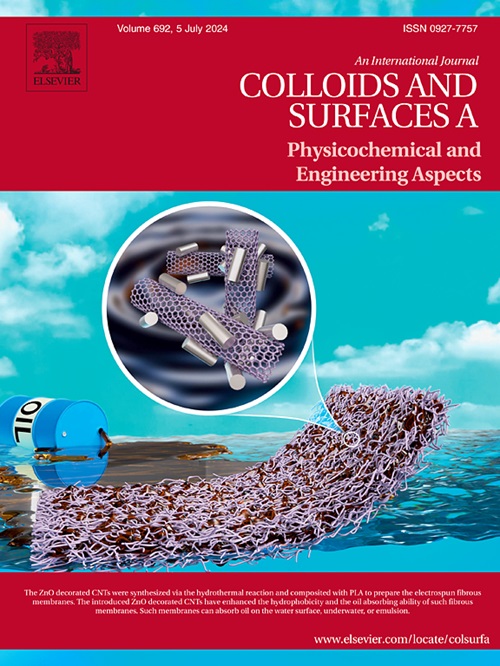绿色高效浮选药剂在褐铁矿和石英反浮选分离中的吸附机理研究
IF 5.4
2区 化学
Q2 CHEMISTRY, PHYSICAL
Colloids and Surfaces A: Physicochemical and Engineering Aspects
Pub Date : 2025-07-23
DOI:10.1016/j.colsurfa.2025.137849
引用次数: 0
摘要
在十二烷基胺(DDA)浮选体系中,采用绿色高效浮选剂聚天冬氨酸(PASP)实现了褐铁矿和石英的高效反浮选分离。浮选试验发现,在pH为6、DDA浓度为75 mg/L、PASP浓度为5 mg/L的条件下,褐铁矿与石英的浮选效果相差最大,达86.02 %。接触角试验表明,DDA和PASP同时作用后,褐铁矿的接触角比单独作用时减小了26.93°,而石英的接触角增大了8.68°。Zeta电位和红外光谱分析表明,PASP在褐铁矿表面有强吸附,阻碍了DDA在褐铁矿表面的吸附;PASP在石英表面有弱吸附,对DDA在石英表面的吸附影响较小。XPS分析表明,PASP对褐铁矿表面的Fe位点有较强的吸附作用,而对石英表面的Si位点的吸附作用较弱,表明PASP对褐铁矿具有选择性吸附特性。扩展的Derjaguin-Landau-Verwey-Overbeek (E-DLVO)理论计算表明,PASP的引入将DDA体系中褐铁矿颗粒与气泡之间的总相互吸引能转化为总相互排斥能,而石英颗粒与气泡之间的总相互吸引能基本保持不变,导致褐铁矿下沉,石英上升,有利于褐铁矿与石英的反浮选分离。本文章由计算机程序翻译,如有差异,请以英文原文为准。
Study on the adsorption mechanism of green and efficient flotation reagents in the reverse flotation separation of limonite and quartz
This study achieved efficient reverse flotation separation of limonite and quartz using a green and efficient flotation reagent, polyaspartic acid (PASP), in the dodecylamine (DDA) flotation system. The flotation test found that under the conditions of pH 6, DDA concentration of 75 mg/L, and PASP concentration of 5 mg/L, the most significant flotation difference of 86.02 % was achieved between limonite and quartz. The contact angle test showed that after the simultaneous action of DDA and PASP, the contact angle of limonite decreased by 26.93° compared to DDA alone, while the contact angle of quartz increased by 8.68°. Zeta potential and infrared spectroscopy analysis indicated that PASP strongly adsorbed on limonite surface, hindering the adsorption of DDA on limonite surface, and weakly adsorbing on quartz surface, slightly affecting the adsorption of DDA on the surface of quartz. XPS analysis showed that PASP had a strong adsorption effect on Fe sites on limonite, while its effect on Si sites on quartz surface was weak, indicating selective adsorption characteristics on limonite. Extended Derjaguin–Landau–Verwey–Overbeek (E–DLVO) theoretical calculations showed that the introduction of PASP transformed the total mutual attraction energy between limonite particles and bubbles in the DDA system into total mutual repulsion energy, while the total mutual attraction energy between quartz particles and bubbles remained basically unchanged, causing the sinking of limonite and the rising of quartz, which was beneficial for the reverse flotation separation of limonite and quartz.
求助全文
通过发布文献求助,成功后即可免费获取论文全文。
去求助
来源期刊
CiteScore
8.70
自引率
9.60%
发文量
2421
审稿时长
56 days
期刊介绍:
Colloids and Surfaces A: Physicochemical and Engineering Aspects is an international journal devoted to the science underlying applications of colloids and interfacial phenomena.
The journal aims at publishing high quality research papers featuring new materials or new insights into the role of colloid and interface science in (for example) food, energy, minerals processing, pharmaceuticals or the environment.

 求助内容:
求助内容: 应助结果提醒方式:
应助结果提醒方式:


